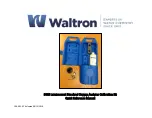
EX622-en-GB_v2.8 4/15
3
SAFETY NOTES
Do not exceed the maximum allowable input range of any function.
Do not apply voltage to meter when resistance function is selected.
Set the function switch OFF when the meter is not in use.
Remove the battery if meter is to be stored for longer than 60 days.
WARNINGS
Set function switch to the appropriate position before measuring.
When measuring volts do not switch to current/resistance modes.
Do not measure current on a circuit whose voltage exceeds 600V.
When changing ranges always disconnect the test leads from the circuit under test.
CAUTIONS
Improper use of this meter can cause damage, shock, injury or death. Read and understand
this user manual before operating the meter.
Always remove the test leads before replacing the battery or fuses.
Inspect the condition of the test leads and the meter itself for any damage before operating the
meter. Repair or replace any damage before use.
Use great care when making measurements if the voltages are greater than 25VAC rms or
35VDC. These voltages are considered a shock hazard.
Always discharge capacitors and remove power from the device under test before performing
Diode, Resistance or Continuity tests.
Voltage checks on electrical outlets can be difficult and misleading because of the uncertainty
of connection to the recessed electrical contacts. Other means should be used to ensure that
the terminals are not "live".
If the equipment is used in a manner not specified by the manufacturer, the protection provided
by the equipment may be impaired.
This device is not a toy and must not reach children’s hands. It contains hazardous objects as
well as small parts that the children could swallow. In case a child swallows any of them,
please contact a physician immediately
Do not leave batteries and packing material lying around unattended; they can be dangerous
for children if they use them as toys
In case the device is going to be unused for an extended period of time, remove the batteries
to prevent them from training
Expired or damaged batteries can cause cauterization on contact with the skin. Always,
therefore, use suitable hand gloves in such cases
See that the batteries are not short-circuited. Do not throw batteries into the fire.
Do not directly view or direct the laser pointer at an eye.
Low power visible lasers do not
normally present a hazard, but may present some potential for hazard if viewed directly for
extended periods of time
Function Maximum
Input
A AC,
400A DC/AC
V DC, V AC
600V DC/AC
Resistance, Capacitance, Frequency, Diode Test
250V DC/AC
A 4000
A
Type K Temperature
30V DC, 24V AC

































